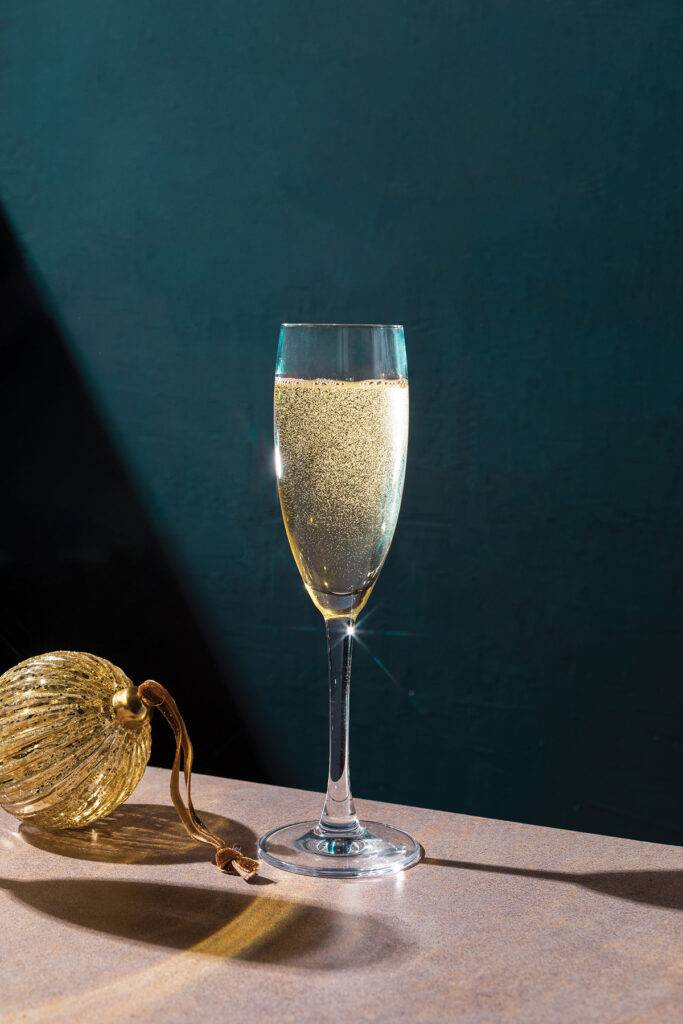Stock up on sparkling wines and you’ll be ready for every event over the festive weeks ahead.

By Joanne Sasvari
There’s this idea that bubbles should only be served on special occasions. That’s a terrible idea.
Sparkling wines are among the most versatile, food-friendly sippers out there, perfect for any occasion from a gala celebration to, well, just because.
That said, different types of fizz are better paired with different types of foods, events and budgets. You’re probably not swilling vintage Krug with your Tuesday takeout, just as you probably want something fancier than Baby Duck to toast a milestone anniversary.
Here’s how to pick the bubble that’s right for you.
What is Sparkling Wine Anyway?
Sparkling wines start off as still wines made from red and/or white grapes. Then carbon dioxide, or CO2, is added to create that festive fizz. How it’s added is what makes the difference between budget plonk and a bottle that can set you back a few hundred bucks and be worth every penny.
The cheapest way to make bubbles is simply to add CO2 gas to wine in a pressurized vat, the same way you’d make soda pop. This creates big, short-lived bubbles and not terribly complex wines.
Another relatively inexpensive — but much tastier — way to make sparkling wines is what is known as the Charmat or tank method. Still wine is placed in a pressurized tank, sugar and yeast are added, and the wine undergoes a secondary fermentation during which CO2 is produced and preserved in the wine.
These wines tend to retain their fruity character and can be slightly sweet, with soft bubbles that dissipate quickly. This is how both Italian Prosecco and Vancouver Island’s signature Charme de L’île are made.
The most prestigious bubbles are made according to the much more labour-intensive Champagne or traditional method. The wine is first fermented just as any other wine would be, but once it is in the bottle, the winemaker adds a dose of yeast and sugar before the bottle is corked. This creates a second fermentation — and bubbles! — in the bottle.
While it ferments, the yeast creates residue known as “lees.” To remove it, bottles are placed in racks with their necks tilted down at an angle and regularly rotated, a process known as “riddling,” so the lees accumulates in the neck, which is eventually frozen and lopped off, the pressure in the bottle forcing the frozen mass out. The bottle is topped with more wine, corked and a wire cage added.
There are some variations to this process, but in general it is how French Champagne is made as well as Spanish cava, B.C. or California Brut, and “crémant,” the name for traditional method wines made in France, but outside the Champagne region.
These wines tend to have fine, lingering bubbles (known as the mousse) and crisp, complex flavours that combine bright citrus and toasty, brioche notes. Some can be aged for many years, adding rich layers of even more complexity.
There is one other method, known as ancestrale or pét-nat (short for “pétillant-naturel”), which is especially popular among natural wine aficionados. This wine does not go through a second fermentation, but is bottled before the first one is complete. It’s tricky to do well, but can create truly exciting, fresh and mouth-watering wines.
Bubbles for Every Occasion
So what type of bubble should you be serving? One of these seven different styles.
1 Charme de L’île: This affordable, locally produced crowd pleaser is a good choice for larger parties and casual events. It pairs well with seafood and Asian flavours, and is an easygoing partner for canapés and cheese plates. The delicate red fruit note of rosé Charme makes it ideal with charcuterie.
Try: Averill Creek Charme de L’île, Unsworth Charme de L’île Rosé
2 Prosecco: A lovely brunch wine or aperitivo. Soft, a little fruity, a gentle way to start the day — or to end it before the evening begins.
Try: Nino Franco Rustico Valdobiaddene Prosecco Superiore Brut
3 Lambrusco: This sparkling red wine from Italy’s Emilia-Romagna is hugely popular among the cork-dork set for its bright acidity, soft tannins and pleasantly fruity flavours. Serve it with pizza or hearty pasta.
Try: Lambrusco Reggiano Frizzante Medici Ermete Concerto Organic
4 Pét-nat: Fresh, light and juicy with soft bubbles. Pair this natural wine with creamy cheeses and lighter dishes like salads and seafood.
Try: Releases from B.C.’s Sperling Vineyards or Bella Wines
5 Cava: Its firm bubbles and relatively neutral flavours make this Spanish bubble a good base for fizzy cocktails like the French 75.
Try: Segura Viudas Cava Reserva Brut
6 B.C. Brut: Crisp, complex and sophisticated, these traditional method bubbles are a terrific value, go with a huge range of foods and are ideal for almost any occasion, especially if you like to support local. They also make excellent host gifts.
Try: Blue Mountain Gold Label Brut; Vigneti Zanatta Tradizionale Brut; Blue Grouse Paula Sparkling
7 Champagne: The classic French bubble is not cheap and getting more expensive all the time, so you likely want to save it for special occasions. Serve it with caviar, freshly shucked oysters or a fancy seafood tower. If you’re lucky enough to get your hands on a vintage Champagne, pour it alongside poached lobster or creamy truffled chicken.
Try: Taittinger Grand Brut or Perrier-Jouet Grand Epoque
